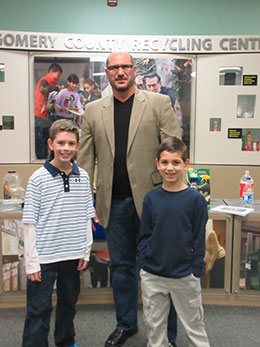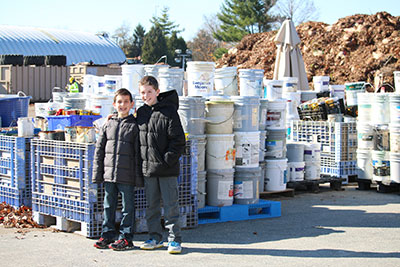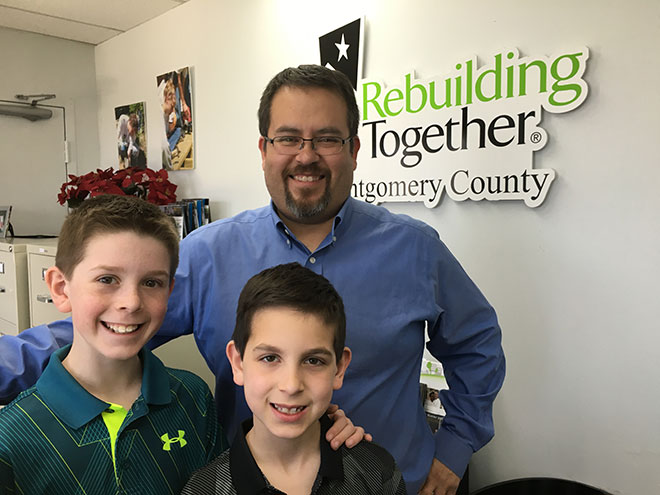PROGRAM INFORMATION
RESOURCES
- Frequently Asked Questions
- Guidelines for Students
- Guidelines for Teachers
- Information for Nonprofit Organizations
STATE & NATIONAL RESOURCES
Highlighting Student Service
Joshua Freedman
7th Grade
Robert Frost Middle School
 My name is Joshua Freedman, and I am a seventh grader at Robert Frost Middle School. My brother Charles and I created a program that the Montgomery County Recycling Center, various non-profit organizations, and the Earth will benefit from. In order to understand my program you first need to understand why I created it. Last year, our house had a flood, and I saw that during the construction there was a ton of extra paint. I wondered what happens to all that extra paint since paint, especially oil-based paints, are very harmful to the Earth if not disposed of properly. People dump them down the sink, spill them into the ground, and throw them out in the regular trash. Charles and I wanted to find out what is done locally, so we visited the Montgomery County Division of Solid Waste Services and at this site, there is a location specifically for Hazardous Home Waste, also known as HHW. We spoke with two employees there, Yannick Mitheo and Tate Easter, and learned that there is a first-come, first-served opportunity for residents to get free paint, but it is for anyone, not for those who really may need it and cannot afford it otherwise.
My name is Joshua Freedman, and I am a seventh grader at Robert Frost Middle School. My brother Charles and I created a program that the Montgomery County Recycling Center, various non-profit organizations, and the Earth will benefit from. In order to understand my program you first need to understand why I created it. Last year, our house had a flood, and I saw that during the construction there was a ton of extra paint. I wondered what happens to all that extra paint since paint, especially oil-based paints, are very harmful to the Earth if not disposed of properly. People dump them down the sink, spill them into the ground, and throw them out in the regular trash. Charles and I wanted to find out what is done locally, so we visited the Montgomery County Division of Solid Waste Services and at this site, there is a location specifically for Hazardous Home Waste, also known as HHW. We spoke with two employees there, Yannick Mitheo and Tate Easter, and learned that there is a first-come, first-served opportunity for residents to get free paint, but it is for anyone, not for those who really may need it and cannot afford it otherwise.
Some of the paints that can be recycled are stored on-site, mixed on-site (to create a standard color in large quantities), placed into crates and shipped to Hondures, El Salvador or the Dominican Republic to be used for schools, hospitals, and other places by charitable organizations. What is not recycled is placed in a cubic yard box, and an absorbant is added to the paint, causing it to dry and solidify. Those hard blocks of paint are then incinerated and the ashes are dumped in a landfill.
According to Tate Easter, paint is the #1 product that is disposed of at HHW, with the average busy day bringing in over 800 one gallon cans, and over 75 five gallon cans of paint.
I think that while it is important to continue to help out the places that are currently receiving the paint, but why, with so much coming in to HHW, couldn’t there be some local non-profit organizations that would benefit from the surplus of unused paint? This would further reduce the amount incinerated and the amount placed in landfills. Mr. Easter stated that he felt there is, “more than enough paint coming in for multiple organizations to benefit from”.
Many of the problems usually faced with donations have already been taken care of by Montgomery County’s Hazardous Waste Program. There is already a convenient location for individuals to drop-off their unused paint, the storage space is already there to house the unused paint, and a paint crew already comes to the site twice a week to mix the paint, and then re-package it in five gallon containers.
All that is needed is to connect the proper non-profit local organizations with Montgomery County’s Division of Solid Waste Services is for the Division of Solid Waste Services to agree to hold aside specific amounts of paint on a scheduled basis for non-profits, and approval from the county for this program to begin. We then spent a lot of time researching non-profit organizations in the area that can benefit from this program, and put together a list of seven based on their mission statements. The next step was for us to meet with Mr. Jeff Camera, who is the head of the Recycling Program for all of Montgomery County at the Department of Environmental Protection, Division of Solid Waste Services. Charles and I explained to him that creating this is clearly a win-win situation because it helps local non-profits help out members of the Montgomery County community, it further reduces the breakdown of harsh chemicals in our Earth, and it would be a shining example of how a county program can use its resources to give back in a meaningful way to the community it is serving.
 Mr. Camera loved the idea, and when the Division of Solid Waste Services’ legal department approved the letter formally agreeing to the partnership, my brother and I took the letter to each non-profit organization, explained the benefits to the organization’s director, and hopefully created meaningful partnerships that will help those most in need in our community. We received a lot of positive feedback from the non-profits, and they were thrilled that specific amounts would be held for them exclusively on an ongoing basis, something that had never been done before. We then went back to each nonprofit later to collect letters from them pledging their interest and commitment, and how much paint they wanted and on what schedule. We returned these letters to Mr. Camera, and he is making sure that the nonprofits receive what they need. This was a much bigger project than I had originally thought I would be doing, but I am committed to making these long-term meaningful partnerships a reality that will benefit the Division of Solid Waste Services, local non-profit organizations and the Earth.
Mr. Camera loved the idea, and when the Division of Solid Waste Services’ legal department approved the letter formally agreeing to the partnership, my brother and I took the letter to each non-profit organization, explained the benefits to the organization’s director, and hopefully created meaningful partnerships that will help those most in need in our community. We received a lot of positive feedback from the non-profits, and they were thrilled that specific amounts would be held for them exclusively on an ongoing basis, something that had never been done before. We then went back to each nonprofit later to collect letters from them pledging their interest and commitment, and how much paint they wanted and on what schedule. We returned these letters to Mr. Camera, and he is making sure that the nonprofits receive what they need. This was a much bigger project than I had originally thought I would be doing, but I am committed to making these long-term meaningful partnerships a reality that will benefit the Division of Solid Waste Services, local non-profit organizations and the Earth.
From this experience, I learned that I’m not too young to make a difference and that other kids just like me can give back to their community and improve the world we live in.
